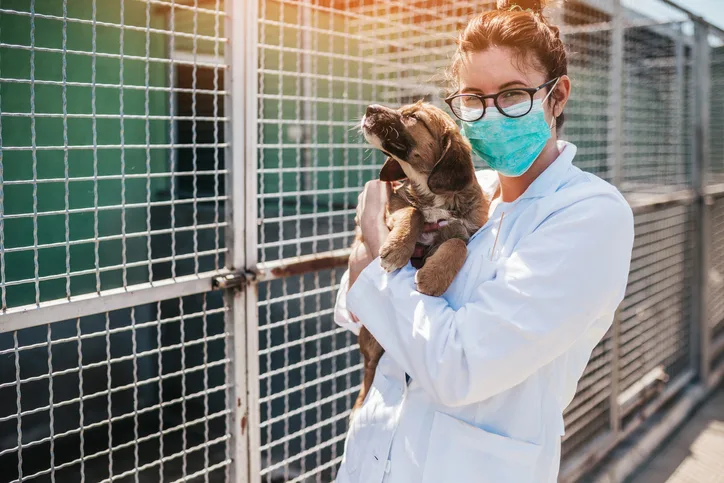
Veterinary medicine has many career opportunities, from general practitioners to specialists, each with unique challenges and benefits. In this series, veterinarians in different fields discuss the realities of their daily work and help bridge the gap between specialties.
Shelter veterinarians care for underserved animals, including those that are neglected and abused. Working in shelter medicine can be rewarding; however, there are also unique challenges and misconceptions. Natalie Weekes, VMD, and Lucy Fuller, DVM, provide a glimpse into the life of a shelter veterinarian.
What brought you to shelter medicine? Do you have any special training?
“Shelter medicine wasn’t even on my radar,” said Dr. Weekes. “But the amount of surgery required and the ability to help some of the most vulnerable animals in my community convinced me to make the switch from private practice. Now I can’t see myself doing anything else.”
“I originally studied exotic animal medicine, but I decided not to pursue that as a career,” said Dr. Fuller. “When I moved, it was difficult to find a job, but a position in shelter medicine opened up, and it turned out to be exactly what I would have pursued if it had been offered as a focus in veterinary school.” To help build her skills, Dr. Fuller sought special training, including high-volume spay and neuter training and a certificate in shelter medicine.
What does an average day look like in the shelter?
“A typical day usually begins with surgery, typically spays and neuters,” said Dr. Weekes. “We also perform any other procedures (eg, mass removals, amputations, enucleations) needed to get the animals as healthy as they can be before going to their adoptive homes. If you enjoy performing surgery, shelter medicine has a wide variety to offer.”
“In the afternoons,” Dr. Weekes continued, “we typically see those animals with health concerns. Every shelter differs in the resources they offer, but ours offers in-house blood work, radiography, and ultrasonography. The goal is to diagnose and treat any potential medical issues before adoption.”
“We typically work 40 to 45 hours per week, or ≈8 to 9 hours per day,” said Dr. Fuller. “We try not to have long hours because work–life balance is important, and we try to rotate between surgery and shelter medicine.”
How does shelter medicine differ from general practice?
“The biggest difference is thinking about each individual animal plus the health of the entire population; there is a lot of disease management,” said Dr. Weekes. “There are also gut-wrenching cruelty and neglect cases, but watching an animal’s transformation and testifying in court on their behalf can be extremely rewarding.”
“Stress-wise, shelter medicine is comparable to general practice, but it’s a different kind of stress,” Dr. Weekes added. “The stress is more about preventing outbreak of infectious disease in the shelter, and if there is an outbreak, figuring out how to best quarantine and isolate parts of the population.”
“In general practice, a lot of time is spent on client education,” said Dr. Fuller. “Whereas shelter veterinarians spend a lot of time ensuring animals are moving through the shelter. Most of my time is spent examining patients because there are so many of them, but I also do a lot of recordkeeping to ensure animals are on the right path and the right medication.”
What are the best parts about working in shelter medicine? What are the challenges?
“The best part of shelter medicine is making a difference in the lives of animals that have no one to advocate for them,” said Dr. Weekes.
“Shelter medicine is a great way to make a difference for a lot of animals, and we have an excellent and active student program,” said Dr. Fuller. “Students come here for surgical and spay and neuter training, and it’s a great way to be exposed to shelter medicine.”
“Another thing I like is how shelter medicine allows you to be creative,” Dr. Fuller added. “We see a variety of cases that are unlikely in general practice. Because we are not limited by what treatments clients are able to afford, we are able to provide a different level of care.”
With the best parts also come challenges.
“One of the biggest challenges is the emotional toll,” said Dr. Weekes. “Shelter veterinarians are exposed to some of the worst possible cases and need to have resiliency and a good support network. I don’t dwell on the past hardships of an animal. I try to have the mindset that now they’re in our care, and we can help them heal and ensure their life will be great from this point on.”
“We see many challenging cases (eg, behavioral euthanasia, cruelty),” said Dr. Fuller. “It can be difficult to decide which dogs can be put up for adoption.”
“Shelters typically have high intake in the summer,” Dr. Fuller added. “Often more animals come in than we have cages for, and the constant question is ‘Where can I put this animal?’ It can lead to a feeling of burnout by the end of the season. Shelters are also staying full for longer periods of time, which can take a toll on the animals’ mental and physical health.”
Are there any misconceptions about shelter medicine?
“In the past, there was a stigma that shelter veterinarians practice subpar medicine,” said Dr. Weekes, “but this view may be changing. Shelter veterinarians are commonly experts in public health, infectious disease, surgery, forensics, and trauma medicine.”
Do you have any advice for those considering shelter medicine?
“I think many people would fall in love with shelter medicine if they tried it,” said Dr. Weekes. “There’s such variety, and no day is boring. You get to serve the most underserved population of animals, which feels great.”
“We have a great social media page, as well as other resources, like the Association of Shelter Veterinarians (see Suggested Reading),” said Dr. Fuller. “We’re a welcoming group and love to bring people into the fold.”